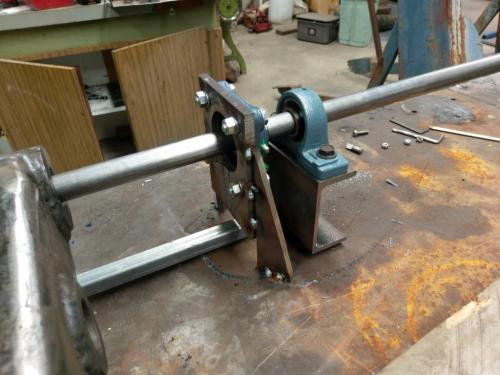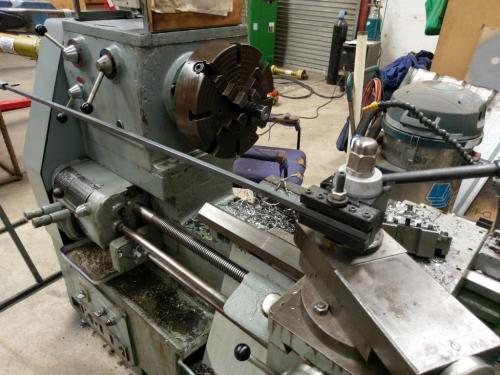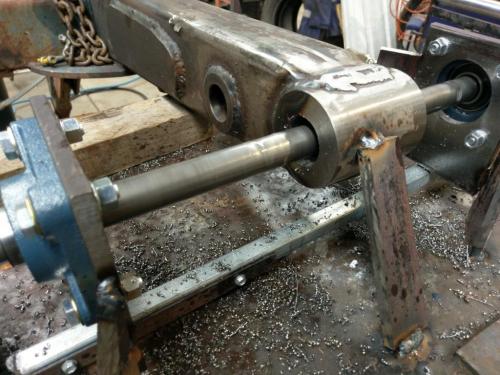I actually made a start on the line boring today, might even have got the front bores finished if we hadn't had a power failure. A few more photos of the setup:
I made up some plates to mount the flange-mount bearing housings, there's enough slop in the bolt holes for some aligning once they're tacked down to the bench

the bearing carrier plates were hung from the shaft while I got it aligned where I wanted it, then a few pieces of scrap offcuts used to suspend them in position. The feed rod slides through the gap underneath

To explain what may or may not be obvious, the shaft is free to slide back and forth through the four flange-mount bearings, which allows for the feed. The one pillow-block bearing is fixed to the shaft with grub screws, one of which is located in a hole in the shaft to provide a positive position.
The pillow block bearing is moved by a long rod (cobbled together from offcuts), the other end of which is in the lathe toolpost

so the lathe provides both rotation and feed.
I had to add some more bracing from the front of the loader arms to the bench, the bench itself is not really rigid enough for the task- the top is only 5mm thick and there's no diagonal bracing in the frame. I bored the one nearest to the lathe first, it had much less twist than the other so there were only a couple of passes with an interrupted cut, once it was cutting continuously it was nice and smooth and I got a good finish in the bore. The other end has a fair bit of misalignment so I've made several passes with an interrupted cut and it was setting up a fair bit of wobble in the bench. I might add some temporary bracing to the bench frame if I can find suitable scrap lengths.
I took a video of the contraption in action but I don't think I can post it. a photo will have to do.

I made up some plates to mount the flange-mount bearing housings, there's enough slop in the bolt holes for some aligning once they're tacked down to the bench
the bearing carrier plates were hung from the shaft while I got it aligned where I wanted it, then a few pieces of scrap offcuts used to suspend them in position. The feed rod slides through the gap underneath
To explain what may or may not be obvious, the shaft is free to slide back and forth through the four flange-mount bearings, which allows for the feed. The one pillow-block bearing is fixed to the shaft with grub screws, one of which is located in a hole in the shaft to provide a positive position.
The pillow block bearing is moved by a long rod (cobbled together from offcuts), the other end of which is in the lathe toolpost
so the lathe provides both rotation and feed.
I had to add some more bracing from the front of the loader arms to the bench, the bench itself is not really rigid enough for the task- the top is only 5mm thick and there's no diagonal bracing in the frame. I bored the one nearest to the lathe first, it had much less twist than the other so there were only a couple of passes with an interrupted cut, once it was cutting continuously it was nice and smooth and I got a good finish in the bore. The other end has a fair bit of misalignment so I've made several passes with an interrupted cut and it was setting up a fair bit of wobble in the bench. I might add some temporary bracing to the bench frame if I can find suitable scrap lengths.
I took a video of the contraption in action but I don't think I can post it. a photo will have to do.
Lathe (n); a machine tool used in the production of milling machine components.
Milling Machine (n); a machine tool used in the production of lathe components.
Milling Machine (n); a machine tool used in the production of lathe components.




